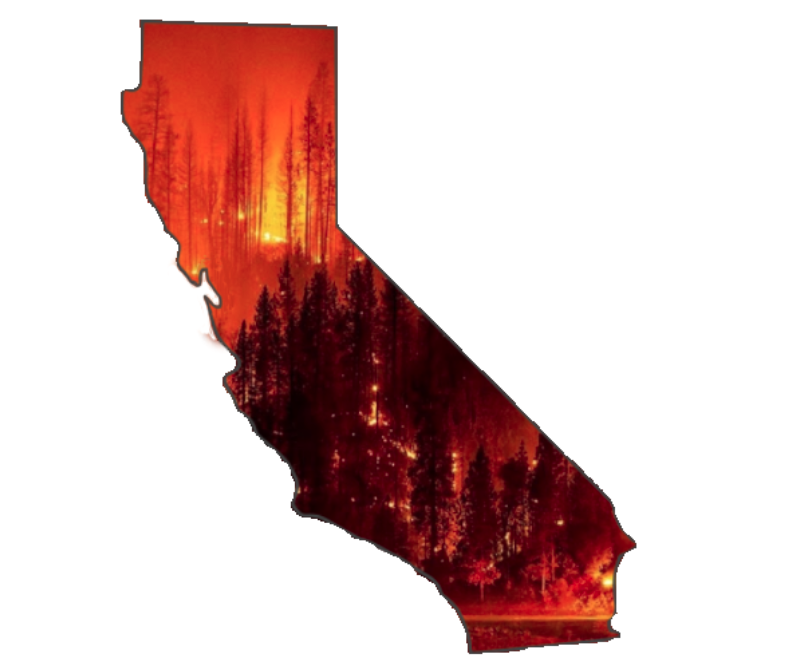How humans worsened California’s 2020 wildfire season
Human impact played a significant role in the devastating 2020 wildlife season.
March 23, 2021
The dramatic increase in California’s 2020 wildfires might just be the consequences of human actions and climate change.
There are three conditions that a wildfire needs: fuel, air and a heat source, referred to as the ‘fire triangle’ by firefighters. Climate change is actively affecting two of these factors–the amounts of fuel and air–making 2020 the worst fire season in California’s modern history.
Average global temperatures are about 1.8 degrees Fahrenheit higher than the temperature necessary to maintain a balanced ecosystem. In California, the temperatures have increased by 3 degrees Fahrenheit.
With even the slightest variation of temperatures can result in the hottest and driest winds, which lead to the accumulation of dead and dry fuel: perfect ingredients for a wildfire.
“Essentially, you now have dead trees in huge parts of the state,” Mike Agustin, Captain of the Alameda County Fire Department said, “[With] warm winds [and] low moisture in the air … it just takes a spark for something big.”
In 2014, millions of trees died, to the point where even deep-rooted trees could not find any moisture in the soil. By 2015, it became evident that this mass obliteration would only increase each year. In 2016, about 100 millions trees were killed permanently, 80% of which were higher elevations. This dead vegetation is still here: fuel for a forest fire.
A problem that many firefighters are facing is the varying densities of the forests, due to unbalanced relationships between logging companies and forest conservation organizations. This leaves alternating patches of bare dry land and thick forests.
“Imagine if [you] had a pile of matches. You [light] one match and [the fire] would be able to spread to all of them really quick,” Agustin explained. “If you spread [the matches] out a little bit and have spaces between them … you [would have to] blow it a little, before it got to the next batch.”
Our forests are essentially piles of matchsticks waiting for a spark. When it does, forest fires rage with great speed and intensity, covering large areas in a short amount of time to the density of the forests and dead vegetation as fuel.
Agustin believes that by having pre-positioned fire tankers in the air, ready to combat fires and create barriers, could help prevent future wildfires on especially hot and dry days during the California fire season.
“It’s not easy … but it’s worth the money and the effort to have … Right now, [we are trying] to make a barrier as the fire is going and it’s really hard,” Agustin said.
“The tricky thing about fires [is]—it isn’t any one thing that’s causing them, it’s multiple puzzle pieces fitting together,” Jennifer Balch, a fire ecologist at the University of Colorado, Boulder, told National Geographic.
Humans and Fires
Human-caused climate change accounts for more than half of the dry burnable materials that increase fire risk. Calling the fires “wildfires” is a misnomer. A study from the National Academy of Sciences revealed that about 84% of all ‘wildfires’ are caused by humans. This includes campfires, cigarettes, electrical failure and arson.
“With the wildfires that were ravaging the North Bay [area], there are still investigations on how responsible PG&E[’s] power lines [were],” Annie Nguyen, DVHS Environmental Science teacher, said. “We have reached a point of neglect where the power lines could spark and then ignite trees that are nearby.”
Many of California’s recent wildfires have been caused by extreme lightning complexes. People are indirectly affecting the conditions for a fire to start, due to increase in the temperature, wind and static electricity, which in turn, causes dry lightning storms with little wind.
The past decade saw an average of 770,000 acres burned in California due to wildfires each year. In 2020 alone, the numbers soared to 4 million, and the year is not even finished.
“[But] we have reached a point where we are living in these places, and we’re no longer separate from nature … because we are continu[ally] build[ing] into these habitats that have a tendency towards fire,” Nguyen said.
Just because some ecosystems are built to withstand wildfires does not always mean they will recover afterwards. They will not always have the right climatic resources to rebuild, and humans often disturb the process of rehabilitation.
Only now has the average citizen begun to notice the increase in fire activity, as this year’s burned acreage is double that of 2018’s fire season, which was the highest until now.
“Those fires in August were so devastating and hard to ignore, because we experienced yellow skies, and we had poor air quality for over 30 days,” Nguyen said. “This is the first year that we’ve really had to take notice of [what’s] happening here in California.”
As individuals, it is our responsibility to reduce our impact as much as we can, whether that’s putting out a campfire, snubbing out a cigarette and keeping our cars in good condition.
Although 2020 has been a particularly tough year for many, there are still world problems that are getting worse. By reducing our carbon emissions, eating less meat, banning palm oil products, and reducing transportation by cars and planes, we can effectively change the course of where our planet is heading.
One easy first step to fighting climate change is taking an online carbon footprint calculator, to see your impact on the carbon dioxide you are releasing.
As Greta Thunberg said, “I want you to act as if your house is on fire, because it is.”


